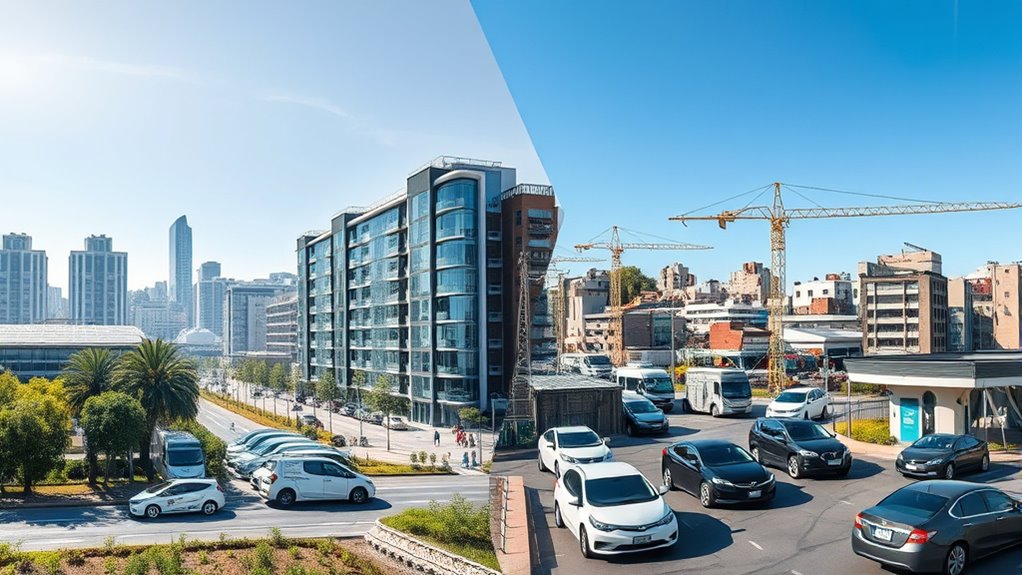Leasing an electric vehicle might seem greener initially because it often involves newer, more efficient models and encourages frequent upgrades. However, when you consider the full lifecycle, buying and extending its use can lower overall manufacturing emissions, especially if you drive it long-term. The environmental benefit depends on your driving habits and how long you keep the car. Stay with us to see how lifecycle factors can tip the balance in this environmental showdown.
Key Takeaways
- Leasing often results in more frequent vehicle turnover, increasing total manufacturing emissions over time.
- Buying and maintaining an EV longer spreads out manufacturing impacts, reducing overall environmental footprint.
- Extended vehicle use enhances sustainability, especially if the EV is used extensively and maintained properly.
- Advances in sustainable manufacturing and recycling are decreasing the environmental impact of EV production.
- The greener option depends on individual usage patterns, vehicle lifespan, and evolving manufacturing practices.

Have you ever wondered which activities are truly the biggest threats to our environment? When it comes to transportation, electric vehicles are often praised for their zero tailpipe emissions, but their overall environmental impact is more complex. Understanding the electric vehicle lifecycle is vital to grasping whether leasing or buying is greener. From the moment an EV is manufactured to the day it’s retired, every stage influences its environmental footprint. Manufacturing emissions, in particular, play a significant role during the production phase. Producing EV batteries requires substantial energy and raw materials, often leading to higher emissions compared to traditional vehicles. If you’re considering leasing or buying an electric vehicle, these factors matter because they determine the initial environmental cost.
Electric vehicle lifecycle impacts vary; manufacturing emissions, especially from batteries, significantly influence overall environmental footprint.
Leasing can seem like a more sustainable choice at first glance, especially since many lease agreements encourage regular vehicle turnover. This means you might swap out your EV for newer, more efficient models more frequently, potentially reducing the environmental impact over time. However, it’s essential to think about that the manufacturing emissions involved in producing each new vehicle and its batteries contribute markedly to the overall lifecycle emissions. If you lease multiple EVs over the years, the cumulative manufacturing emissions can add up, possibly offsetting the benefits of driving an electric car.
On the other hand, buying an EV and keeping it for a longer period can spread out the manufacturing emissions over its extended lifespan. This approach can sometimes be more environmentally friendly because fewer vehicles need to be produced and their batteries replaced. Still, the initial manufacturing emissions remain high, and the environmental benefits depend heavily on how long you keep the vehicle and how efficiently you use it. If the EV is driven extensively and maintained well, it can serve as a greener option over its lifetime, despite the upfront impact. Additionally, ongoing innovations in battery recycling and sustainable supply chains are helping to mitigate these concerns.
It’s also worth noting that advances in battery technology and more sustainable manufacturing practices are gradually reducing manufacturing emissions. As automakers improve their processes, the environmental impact of EV production will lessen, making electric vehicles a more attractive option regardless of whether you lease or buy. Ultimately, the decision depends on your driving habits, how long you plan to keep the vehicle, and the ongoing improvements in green manufacturing. Both leasing and buying have environmental trade-offs, but understanding the lifecycle and manufacturing emissions helps you make a more informed, greener choice.
Frequently Asked Questions
How Does Leasing Affect a Company’s Carbon Footprint Long-Term?
You might wonder how leasing impacts your company’s long-term carbon footprint. Leasing can improve fleet management by enabling regular upgrades to more fuel-efficient vehicles, reducing emissions over time. Plus, with emissions tracking tools, you can monitor and optimize your fleet’s environmental impact more effectively. Overall, leasing promotes greener practices by encouraging sustainable choices and making it easier to maintain an eco-friendly fleet.
What Are the Hidden Environmental Costs of Manufacturing New Vehicles?
Think of manufacturing new vehicles as planting a forest of emissions; each step releases hidden environmental costs. Manufacturing emissions surge from energy-intensive processes, while material sourcing often strips natural resources from fragile ecosystems. You might not see the damage at first glance, but behind the scenes, the extraction of raw materials and factory emissions weave a web of environmental strain, reminding you that building new cars leaves a hefty ecological footprint you can’t ignore.
Do Leasing Companies Prioritize Eco-Friendly Options?
You might wonder if leasing companies prioritize eco-friendly options. Many now adopt eco-friendly policies and promote green leasing to attract environmentally conscious customers. They often offer electric or fuel-efficient vehicles, reducing carbon footprints. By choosing a green lease, you’re supporting sustainable practices and encouraging manufacturers to produce more eco-friendly models. Leasing companies increasingly recognize the importance of sustainability, making eco-friendly options more accessible and attractive for responsible consumers like you.
How Does Vehicle Recycling Impact Environmental Benefits of Leasing?
You might wonder how vehicle recycling affects leasing’s environmental benefits. In reality, it plays a vital role, especially with battery recycling and material reuse. When you lease a vehicle, its end-of-life management ensures batteries are properly recycled, reducing hazardous waste. Material reuse further minimizes resource extraction. This process helps decrease environmental impact, making leasing a smarter choice for eco-conscious consumers, as it promotes sustainability throughout the vehicle’s lifecycle.
Are There Industry Standards for Environmental Responsibility in Leasing?
You should know that industry standards for environmental responsibility in leasing are increasingly emphasizing carbon offset programs and renewable energy use. Many leasing companies now aim to reduce their carbon footprint by adopting sustainable practices, like utilizing renewable energy sources and supporting carbon offset initiatives. These standards help guarantee that leasing aligns with environmental goals, encouraging companies to prioritize eco-friendly options and contribute to a greener future.
Conclusion
So, next time you’re pondering whether to lease or buy, remember that today’s choices echo through history’s green battles. While leasing might seem like a modern, eco-friendly move, it’s like choosing the lesser of two evils—think of it as the lesser of two fossil fuels. Ultimately, your decision impacts the planet, so weigh the options carefully. As the old adage goes, “The pen is mightier than the sword,” and in this case, your choice writes a greener future.










